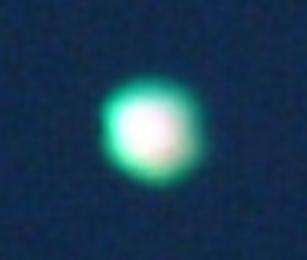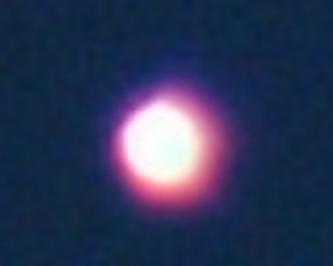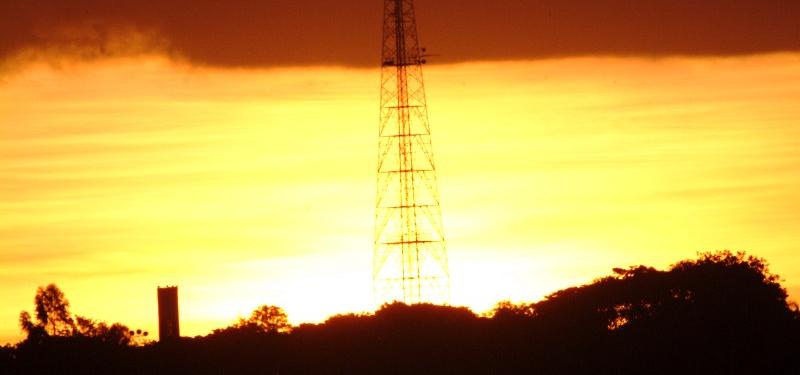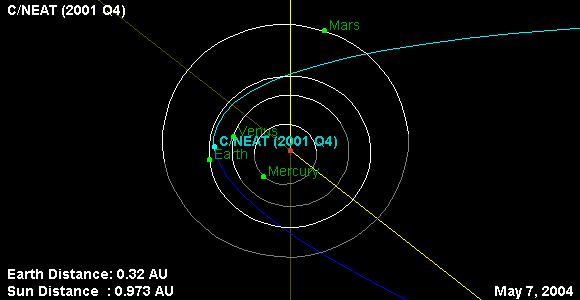

- I took this pictures in Cascavel, Parana South Brazil on Feb 3 at 8:00 PM (summertime). At the time the sun still in the horizon (bottom photo) but I could saw this star, then I shot these 3 photos, the light from it was so strong I could saw even in day light. Its light was stronger than moon or any planets or stars at the moment. We observe this "planet" is already in the solar system because his mass is visible, its not a point of light. We could see its ethereal mass. Another detail. we have observed in the telescope or in the photographic camera (1000mm) his movement in the sky was 60% faster than any star, moon or planet. I took a chronometer to take the time, these start took 2.50 minutes to cross the photographic frame (pentaprism). Are these shots about the X Planet?
- Sergio
- Venus is still visible at 8:00 PM, setting in the West. But as the photographer then photographed this object after Venus sets, at 10:00 PM, it is unlikely to be Venus. Also, the tracked motion indicates it not to be a known planet orbiting the Sun, but another object closer to Earth, thus the speed of transit more noticeable. Note the close hugging dust cloud of Planet X, evident in these photos. Note per the IAU observations of C/2001 Q4, comet NEAT, that this is the most likely explanation.
- Nancy



C/2001 Q4 (NEAT)
Last Updated: 2 February 2004
Reported observations:

2003 Nov 02.37 UT: m1=11.5, Dia.=1'.0, DC=7/9...41cm L (214x)...John Drummond, (Gisborne, New Zealand) [Q4 easily seen despite the 7 day moon. It
appears to have a bright, tight nucleus surrounded by a decent sized coma - resembles a small compact globular cluster].
2003 Nov. 03.27 UT: m1=11.1, Dia=1', DC=4...14.3cmL f/6 (80x)...Alexandre Amorim (Florianopolis,Brazil)[Tycho-2 used]
2003 Nov 03.41 UT: m1=11.4, Dia.=1'.0, DC=6/9...41cm L (214x)...John Drummond (Gisborne, New Zealand) [Q4 easily seen despite the 8 day moon. It has
a bright, almost stellar nucleus surrounded by a decent sized coma]
2003 Nov. 03.94 UT: m1=10.6:,DC=1...20cm /SCT (100x)...Willian Souza (Sao Paulo, Brazil) [moonlight interference]
2003 Nov. 04.06 UT: m1=11.1:,...DC=3...14.3cmL f/6 (80x)...Alexandre Amorim (Florianopolis,Brazil)[Tycho-2 used, moonlight interference]
2003 Nov 05.39 UT: m1=11.4, Dia.=1'.0, DC=6/9, 41cm L (214x)...John Drummond, (Gisborne, New Zealand) [Q4 easily seen despite the 10 day moon. A
small pinpoint nucleus is surrounded by quite a large, bright coma]
2003 Nov 11.36 UT: m1=~11.5, Dia.=1'.0, DC=~6...41cm L (214x)...John Drummond (Gisborne, New Zealand) [Q4 difficult to observe because it's sitting
right over a mag 13.1 star - hard to make observation estimates. Can see a fairly large coma]
2003 Nov. 13.98 UT: m1=11.0, Dia=1', DC=5...14.3cmL f/6 (80x)...Alexandre Amorim(Florianopolis,Brazil)[Tycho-2 used, wind interference]
2003 Nov 14.51 UT: m1=11.3, Dia.=1'.1, DC=6/9, Tail=1'.8?...41cm L (107x & 214x)...John Drummond, (Gisborne, New Zealand) [Q4 continues to brighten.
Can see a fairly large coma with a compact, almost stellar nucleus. I THINK that I can see a 1'.8 tail in a PA of about 330*. Comet's alt is 50* in the S]
2003 Nov 16.42 UT: m1=11.4, Dia.=1', DC=6...33cm L (72x)...Paul Kemp (Auckland, New Zealand) [Q4 is very much like a small face on spiral galaxy,
compact with a bright core. Suprisinly easy to spot. No tail]
2003 Nov 16.48 UT: m1=12.0, Dia.=0'.9, DC=5/9...41cm L (107x & 214x)...John Drummond, (Gisborne, New Zealand) [T3 displays a compact, almost stellar
nucleus]
2003 Nov 16.42 UT: m1=11.4, Dia.=1', DC=6...33cm L (72x)...Paul Kemp (Auckland, New Zealand) [Q4 is very much like a small face on spiral galaxy,
compact with a bright core. Suprisinly easy to spot. No tail]
2003 Nov. 29.08 UT: m1=11.0:, Dia=1', DC=3...14.3cmL f/6 (80x)...Alexandre Amorim(Florianopolis,Brazil)[thin nebulosity]
2003 Dec 01.67 UT: m1=11.6, Dia.=1', DC=4...33cm L (72x)...Paul Kemp (Auckland, New Zealand) [Q4 not showing such concentration and marginally fainter
than previous observation. No tail]
2003 Dec 14.45 UT: m1=9.8, Dia.=1'.7, DC=6/9, Tail=5'.0 PA 62*...20cm L (26x)...John Drummond, (Gisborne, New Zealand) [Through the 16" I can see a
compact, fairly stellar nucleus surrounded by a largish coma. The tail is faintly seen extending for about 5'].
2003 Dec. 14.87 UT: m1 =10.2, Dia. =30", DC =6...15cm L, f/7 42x...Mike Begbie (Harare, Zimbabwe) [First observation. Mag estimate made just before
Moonrise. Comet virtually stellar with a faint outer coma just visible with direct vision, more apparent with averted vision. Altitude low, about 20 degrees. I would
have liked to try earlier in the evening but was thwarted by cloud. ]
2003 Dec 15.40 UT: m1=9.8, Dia.=1'.7, DC=6/9, Tail=4'.0 PA 65*...20cm f4 Reflect (37x)...John Drummond, (Gisborne, New Zealand) [Through the 16" I can
see a compact, fairly stellar nucleus surrounded by a largish coma. The tail is very faint].
2003 Dec. 22.02 UT: m1=10.1, Dia=1.5', DC=5... 20cm SCT, f/10(57x)... Walter R.Robledo (Cordoba, Argentina)[Sidgwick method]
2003 Dec. 22.09 UT: m1=9.8, Dia=1', DC=4...14.3cmL f/6 (80x)...Alexandre Amorim(Florianopolis,Brazil)
2003 Dec 24.50 UT: m1=9.7, Dia.=1'.8, DC=6/9, Tail=4'.0 PA 78*, 20cm L (37x)...John Drummond, (Gisborne, New Zealand) [Through the 16" the nucleus
appears to be a stellar knot surrounded by a nice coma. The tail is very faint and fan shaped.]
2003 Dec 25.53 UT: m1=10.0 ccd R, Dia.=3', DC=5, Tail: 3' in PA 65 deg... 140mm f/2.8 telephoto + CCD... Vello Tabur (Canberra, Australia) [Red mag +/-
0.1]
2003 Dec 26.45 UT: m1=9.7, Dia.=1'.9, DC=6/9, Tail=3'.0 PA 70*, 20cm L (37x)...John Drummond, (Gisborne, New Zealand) [Through the 16" the outer
coma surrounds a brighter inner coma which contains a bright, tight nucleus. The tail is still faint and fan shaped.]
2003 Dec 27.40 UT: m1=9.6, Dia.=2'.0, DC=6/9, Tail=3'.5 PA 75*, 20cm L (37x)...John Drummond, (Gisborne, New Zealand) [Through the 16" the nucleus
appears almost stellar and is surrounded by a largish coma. The tail is faint and fan shaped.]
2003 Dec. 28.14 UT: m1=10.0, Dia=1', DC=3...14.3cmL f/6 (80x)...Alexandre Amorim(Florianopolis,Brazil)[thin nebulosity]
2003 Dec 30.42 UT: m1=9.5, Dia.=2'.0, DC=6/9, 20cm L(37x)...John Drummond, (Gisborne, New Zealand) [Viewed Q4 from a dark country site. Easily
visible. The nuclues is stellar and slightly offset - within the fan-shaped tail(?)]
2004 Jan. 04.20 UT: m1=10.0,...14.3cmL f/6 (80x)...Alexandre Amorim(Florianopolis,Brazil)[moonlight interference]
2004 Jan. 06.00 UT: m1=9.6, Dia=1', DC=5...14.3cmL f/6 (80x)...Alexandre Amorim(Florianopolis,Brazil)[moonlight interference]
2003 Jan. 11.88 UT: m1=12.2, Dia.=1'.5, DC=3...20 cm SCT (100x)...Juan Jose Gonzalez (Sierra del Aramo, alt.1240 m, Asturias, North Spain)
2004 Jan.12.04 UT: m1 = 9.6, Dia = 3', DC = 5, Tail=3´in PA= 90 deg.... 20cm SCT f/10 (57x)... Walter R.Robledo (Cordoba, Argentina)
2004 Jan 23.42 UT: m1=9.4, Dia=4', DC=6, Tail=5' in PA 75...33.3cmL f/5 (114x)...Paul Kemp (Auckland, New Zealand)[Very obvious delta shaped tail]
2004 Jan 23.50 UT: m1=9.0, Dia.=3', DC=6...25x100mm B...Michael Mattiazzo (Clare Valley, South Australia)[coma moderately enhanced by swan band filter]
2004 Jan.26.06 UT: m1 = 9.0 Dia = 3.5', DC = 7, Tail=5´in PA= 130 deg.... 20cm SCT, f/10 (57x)... Walter R.Robledo (Cordoba, Argentina)[out- out
method]*
2004 Jan. 31.12 UT: m1=8.8, Dia=2', DC=3...14.3cmL f/6 (35x)...Alexandre Amorim(Florianopolis,Brazil)[low altitude]